
Race Radio: Why Do Riders Break Away?
The apparent futility of these breakaways begs an obvious question: Why do these riders break away? Don’t they realize that the peloton will simply chase them down?
 You have probably noticed that stages of the USA Pro Challenge follow a similar racing routine. A small group of riders breaks away from the peloton early in the stage. The breakaway gains a sizable advantage on the peloton, only to be pulled back within a few miles of the finish line.
You have probably noticed that stages of the USA Pro Challenge follow a similar racing routine. A small group of riders breaks away from the peloton early in the stage. The breakaway gains a sizable advantage on the peloton, only to be pulled back within a few miles of the finish line.
This dynamic is found in almost every road cycling race, even stages of the Tour de France.
The apparent futility of these breakaways begs an obvious questions: Why do these riders break away? Why expend all of that effort, only to have it come up short? Don’t they know that the peloton will chase them down?
There are numerous reasons why riders attack into breakaways. Some riders are motivated to earn television exposure for their sponsors. Other riders attack with specific strategic goals. The move often forces other teams to chase, for example, allowing a rider's teammates to draft all the way to the finish line.
Other riders see a breakaway as their best chance of winning. If the course is hilly, or if the peloton is tired, breakaways occasionally survive to the finish line. And if a rider is so far behind in the general classification that he poses no risk to the yellow jersey, the controlling team will sometimes let him go.
“For riders like me who can’t sprint, it’s the best chance we’ve got,” says Dylan Girdlestone of the Drapac team. “There’s a 95% chance you’re going to get caught, so it’s still worth it. It’s a gamble.”
Such a scenario played out during Stage 6 from Loveland to Fort Collins. A group of six riders broke away up the Rist Canyon climb, and then charged into Fort Collins with a two-minute gap. Although the peloton gave chase, the break reached the finish line 41 seconds ahead of the group, with Tinkoff-Saxo’s Roman Kreuziger taking the win.
Tom Zirbel of the Optum p/b Kelly Benefits joined the breakaway, and finished 5th. He said he attacked for a variety of reasons.
“We have a good sprinter, and we didn’t want to be caught having to chase the break, which is why I went,” Zirbel said. “And there’s always a chance you can stay away. These opportunities just don’t come too often.”
Within the breakaway, riders from different teams work together to pull away from the group. It’s not uncommon to see riders from rival teams take turns pulling each other toward the finish line. Girdlestone said that breakaway riders communicate with each other to adjust the speed and share the workload. The camaraderie between competitors is unique within sport.
 Although the breakaway riders expel more energy than riders in the peloton, some cyclists prefer to ride ahead.
Although the breakaway riders expel more energy than riders in the peloton, some cyclists prefer to ride ahead.
“It’s less stressful. You just put your head down and suffer,” Girdlestone says. “You don’t have to worry about crashing. It’s a lot less stressful.”
Kreuziger, who finished a mere wheel-length ahead of Javier Megias of Team Novo Nordisk, said his breakaway win salvaged the entire race for his team Tinkoff-Saxo Bank. Kreuziger and his team came to Colorado hoping for a top finish. But after Kreuziger was dropped on the Stage 2 climb to Arapahoe Basin, he began looking for breakaway opportunities.
Stage 6 was held at a comparatively lower altitude, which allowed Kreuziger to attack. And since he entered the stage several minutes down on GC, Kreuziger was not a threat to team BMC, whose rider Rohan Dennis is leading the general classification. When Kreuziger attacked into the breakaway, BMC let him go.
“BMC was nice to let us go,” Kreuziger said. “We knew we were at lower altitudes, so we had to try for the win.”












